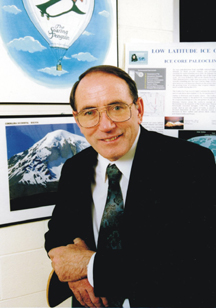 In the 1970s,
the scientific community had low expectations of finding climate records in
alpine glaciers, as such ice bodies were considered much too active to contain
a long climate history. But, while making his first forays into glaciology at
the Ohio State University’s Byrd Polar Research Center, Lonnie Thompson
made the case that it would be worth visiting the Quelccaya glacier — 18,600
feet high — in Peru, after seeing photos of it in one of his mentors’
collections.
In the 1970s,
the scientific community had low expectations of finding climate records in
alpine glaciers, as such ice bodies were considered much too active to contain
a long climate history. But, while making his first forays into glaciology at
the Ohio State University’s Byrd Polar Research Center, Lonnie Thompson
made the case that it would be worth visiting the Quelccaya glacier — 18,600
feet high — in Peru, after seeing photos of it in one of his mentors’
collections. Thompson ended up being quite right: The cores he and his team collected went back 1,500 years. Since then, Thompson has carted tons of ice from the tops of mountains around the world, back to Ohio for storage in a deep-freeze facility. His work exploring some of the most remote alpine glaciers in the world has established their value as a repository of climate data — and their rapid disappearance, which has accelerated alarmingly as global climate changes.
Lonnie Thompson has climbed the world’s mountains in search of icy clues to the planet’s climatic past. Courtesy of the Ohio State University.
In addition to being elected in May to the National Academy of Sciences, Thompson shares this year’s Tyler Prize for Environmental Achievement with Charles Keeling of Scripps Institution of Oceanography in La Jolla, Calif., who established the “Keeling Curve,” documenting changes in atmospheric carbon dioxide levels (see Geotimes, July 2002). “In some ways our two programs fit together very nicely,” says Thompson, who called it an honor to share the award with Keeling. “He’s documented the more recent past, and we’ve looked at the longer term” climate shifts.
Over the past several decades, Thompson has cornered the market on very high glaciers at tropical latitudes, where long climate records are most likely to still survive. These sites often require teams to climb higher than 20,000 feet, carrying several tons of equipment. “I’m not an avid climber,” says Thompson, now 56. “I [have] climbed because that’s sometimes the only way to get to a site for drilling.”
“He goes where no one else goes,” says Don Rodbell of Union College in Schenectady, N.Y., a former postdoc at the Byrd Polar Research Center and current collaborator with Thompson. “Getting that much equipment to 20,000 to 21,000 feet [is] a monumental task, and it’s physically demanding.”
Indeed, obtaining these records can “come at extreme cost,” Rodbell says. Thompson was once diagnosed with pulmonary edema and suffers from asthma, both aggravated at elevation. And, two months after returning home, graduate student Shawn Wight died from complications of a blood clot that arose during a high-altitude expedition with Thompson in 1997. In a wrongful death lawsuit brought by Wight’s parents, the court said that Thompson and the university were not at fault. Colleagues say that the tragedy cast a shadow over Thompson, yet he has remained dogged in his pursuit of the science.
The difficulty of working at such extremes has led Thompson and his colleagues, including his wife Ellen Mosley-Thompson, to improvise what has become an amazing team technique for recovering cores. Among their inventive practices, Bruce Koci and Victor Zagorodnov have built lightweight drills, powered by solar panels and small diesel generators, that are more easily moved up mountainsides than earlier, heavier drills were.
“He and his wife are an amazing team. They built a lab where they can make every kind of measurement,” says Wally Broecker of Columbia University’s Lamont Doherty Earth Observatory in Palisades, N.Y. “Lonnie sans Ellen” is inconceivable, says Richard Alley of Pennsylvania State University. “I think they complement each other brilliantly,” he says.
Thompson says he and his wife have flipped field seasons: “Ellen works in the Antarctic and Greenland, so there was always a parent at home when our daughter was growing up.” The Antarctic summer field season is January and February, and the dry season in the southern tropics is June through August. “When Ellen was off in the field, I would take care of PTA and school things,” he says.
Thompson met Ellen at Marshall University in Huntington, W.V.; only when they went on to graduate work at Ohio State did they both discover ice. Thompson had gone to Marshall on a scholarship to study coal geology, which he saw as a potential escape from the poverty of his hometown, Gassaway, W.V. His parents had completed eighth-grade educations, and Lonnie was the first of his family to attend college (his mother later went back to school).
Some of Thompson’s Tyler prize money went to establishing a scholarship in Braxton County, where he grew up, and to support the new science building at Marshall University, he says. The rest will go to an endowment to maintain the library of ice cores at Ohio State. Stored at minus 30 to minus 40 degrees Celsius, with backup systems in case of power failures, the facility has room for about 7,000 meters of frozen ice cores.
When the team started drilling in the 1970s, Thompson says, “we didn’t realize how rapidly some of these glaciers would be disappearing.” As techniques improve, and alpine glaciers melt, he says, the collection “becomes a very valuable archive for the future.”
Naomi Lubick
Links:
"Presidential accolades for the Keeling curve," Geotimes, July 2002
Ice Core Group at the The Ohio State University Byrd Polar Research Center
Tyler Prize
Back to top

